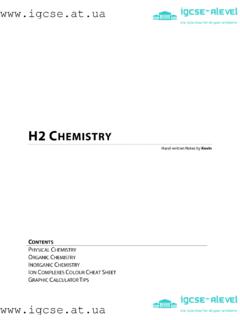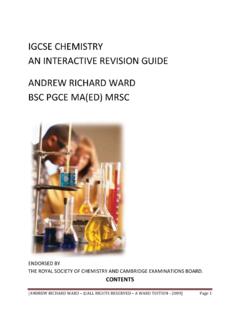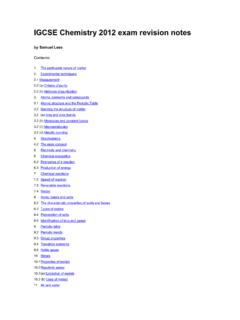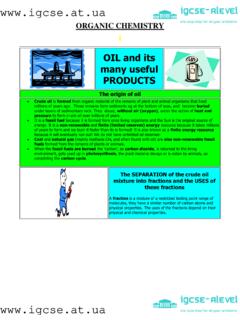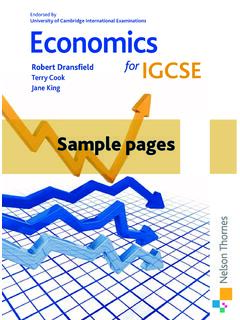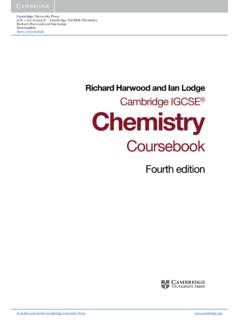Transcription of Examiner Tips for IGCSE Chemistry 0620 FINAL
1 Examiner tips For IGCSE Chemistry 0620 How to use these tips These tips highlight some common mistakes made by students. They are collected under various subheadings to help you when you revise a particular topic. Many of the tips relate to June 2004 papers. PAPER 1 Some questions may ask you to choose a combination of things in order to select the correct answer understand exactly what is required before you start to answer Within a single question, use a pencil to cross out the choices that are clearly incorrect, then choose between the others GENERAL tips FOR PAPERS 2, 3, 5 AND 6 Read the question correctly. For example, if the question says give two observations apart from temperature change , don t include temperature change in your answer Check for contradictions within your answer.
2 For example, a common error is to write a white insoluble precipitate dissolves ( (a)(i)) Show any workings In any calculation, the FINAL answer should be to the correct number of significant figures generally the same as the data. You may be penalized if you write an excess number of significant figures instead of Know your syllabus statements and definitions exactly use the Revision Checklist on the website. Don t add your own ideas to the statements. For example, the syllabus statement on batteries says they are portable , meaning they can be easily carried around: an answer such as they are small may not be accepted, as something can be small yet heavy ( (a)) If asked to describe what you would observe , write down what you see, hear or feel ( the test tube gets hot ).
3 A common mistake is to write something like a gas is given off or copper is deposited ; these are not observations, these are conclusions If asked to describe what you would see , don t note observations about sounds or temperature Learn your definitions! Questions such as what is a compound? or Define the mole. are often poorly answered. Define does not mean give an example of. When drawing diagrams: (i) make sure they fill the space given on the paper and are LABELLED (ii) when drawing apparatus for gas measurement, make sure that the gas cannot escape. For example, don t draw a gas syringe with the plunger much smaller than the syringe barrel this is a common error When asked to give examples, give the number requested by the Examiner .
4 For example, if asked to give two examples, do not give three if one is incorrect, you may lose a mark. If a question asks for a single use for a substance don t write a list the Examiner will think you are playing safe and you won t get the mark ( (d)) If you have to tick boxes to answer a question, make sure that you tick the correct number don t assume that a single answer is always required ( (ft) In Chemistry , when plotting a graph of reaction rate, you must draw a curve of best fit through your prints. Lines drawn with a ruler from point to point will not get a mark ( (b)(i)) Look out for hidden words in questions such as which of the following is a gas containing diatomic molecules? Many students focus on one or two words, and might forget gas.)
5 Underline key words and read the question slowly ( (e)(i)) Avoid vague statements. For example, if the question asks about the use of graphite, the answer graphite is used for electrodes in electrolysis is appropriately specific. Graphite is used in electrolysis, is too vague ( (d)(ii)) PAPERS 1, 2 AND 3: tips ON SPECIFIC TOPICS Acids and bases Don t confuse the pH scale with the degree of acidity. The more acidic the substance, the lower the pH learn this by remembering that a (for acid) is the lowest numbered letter of the alphabet ( ) A common error is to think that less sodium hydroxide is needed to neutralise a weak acid than to neutralise a strong acid of the same concentration.
6 The same amount is needed because the hydroxide is reacting with all the acidic hydrogens in the molecule, not just those that have ionised ( (b)(ii)) The phrase explain why this acid is acting as a base demands a chemical reason (usually based on particle theory). The Examiner is looking for an answer involving proton transfer. Vague answers (such as it is neutralising the base ) are not accepted as they do not give an explanation ( (b)(iv)) Simple inorganic salts such as sodium chloride are generally neutral when dissolved in water they are not acidic ( ) Nitric acid is a strong, not a weak, acid ( (c)) Air and water To remember that carbon monoxide is poisonous (it binds to haemoglobin), think of the nox in carbon monoxide as being short for noxious (poisonous).
7 The effects of pollutant gases on nature are often confused, as not all pollutant gases are acidic. Know the different effects of carbon monoxide, sulphur dioxide and carbon dioxide ( ) A common error is to think that fume cupboards keep air away from a reaction. Fume cupboards have a continuous airflow to allow poisonous vapours to escape through the fan ( (d)) Atomic structure and bonding It is a common mistake to count the bonds and not the electrons when asked about the number of electrons shared between the atoms in a molecule. For example, the number of shared electrons in methane is eight not four ( ) Take care when writing electronic structures including hydrogen. Always show the hydrogen atom either as a circle or (if ionic) by its symbol.
8 It is best practice to write the symbol of the atom in the centre so it is clear to the Examiner which atom is which ( (f)(i)) When writing dot-and-cross diagrams for ionic structures, put the charge outside of the brackets, at the top, not in the centre of the atom When asked about the number of covalent bonds in a compound, focus on the outer energy level / shell electrons that are shared, not the total number of electrons. Remember that some molecules have non-bonding pairs of electrons nitrogen ( (b)(i)) When drawing dot-and-cross diagrams for molecules such as nitrogen which have only three bonding pairs of electrons, don t forget to draw in the lone pairs of electrons. Remember that there must be eight electrons surrounding each atom ( (b)) Practice drawing diagrams of giant molecule structures, including silicon dioxide, diamond and graphite, as these are nearly always drawn badly.
9 You must show the continuation bonds ( (c)(i)) Electrochemistry A common mistake is to think that sulphate ions break up during the electrolysis of aqueous solutions into sulphur dioxide. In fact, oxygen is given off at the positive electrode (from the electrolysis of the water) ( (b)(ii)) If the exam paper shows an electrical circuit to test conduction, observations can also include what can be seen to be happening in the circuit the bulb lights up ( (a)) Energy changes If asked whether a reaction is endothermic or exothermic, remember the following: endothermic heat is put in ( you have to heat with a Bunsen to get a reaction); exothermic heat is given out ( burning fuels and neutralisation reactions are always exothermic) ( ) Equations, formulae and moles If asked for a word equation, do not write a symbol equation.
10 A word equation tests knowledge of chemical names. Although a correct symbol equation is often accepted this is not guaranteed and if you make an error, you won t get the mark A common error is to think that a nitrate ion has a 2- charge. The formula for the nitrate ion is makes the formula for nitric acid HNO3 [( ), ( (a)(i))] The charge on a silver ion is 1+. A common mistake is to think that silver has a 2+ charge When working out formulae, don t be confused by oxidation numbers. A common mistake is to think that the formula for lead(IV) oxide is PbO4 or that lead(II) nitrate is Pb2(NO3). In a formula you have to balance the positive and negative charges. Lead(IV) = 4+, lead(II) = 2+, oxide = 2- and nitrate = 1-. So lead(IV) oxide is PbO2, and lead(II) nitrate is Pb(NO3) 2 ( ) If asked to name a salt formed in a particular reaction, don t put down any other product or you will lose a mark ( (f)(ii)) When explaining redox reactions, make sure you understand exactly what is being asked, especially if the question says use the.



